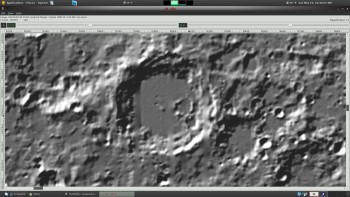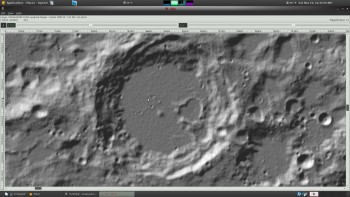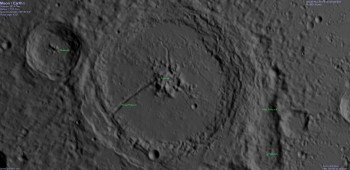LROC news and images |

  |
LROC news and images |
 Sep 30 2011, 01:45 PM Sep 30 2011, 01:45 PM
Post
#406
|
||
|
Solar System Cartographer     Group: Members Posts: 10145 Joined: 5-April 05 From: Canada Member No.: 227 |
Hi James - That abstract is talking about skylight-type features. I'm looking at what I think are small Ina-like features. Here's another one, the 5th I've found in Tranquillitatis.
With Ina and the similar features in Hyginus crater there are seven known examples (single pits or groups of them). I have not found any in other parts of the Moon yet. Phil -------------------- ... because the Solar System ain't gonna map itself.
Also to be found posting similar content on https://mastodon.social/@PhilStooke NOTE: everything created by me which I post on UMSF is considered to be in the public domain (NOT CC, public domain) |
|
|
|
||
 Sep 30 2011, 01:51 PM Sep 30 2011, 01:51 PM
Post
#407
|
|
|
Junior Member   Group: Members Posts: 62 Joined: 30-July 09 Member No.: 4887 |
Hi James - That abstract is talking about skylight-type features. I'm looking at what I think are small Ina-like features. Here's another one, the 5th I've found in Tranquillitatis. With Ina and the similar features in Hyginus crater there are seven known examples (single pits or groups of them). I have not found any in other parts of the Moon yet. Those are quite interesting and different. May I ask you how you handle discoveries of this type? In peer review science, it seems a long process before such discoveries are released via expensive journals. There does not seem to be an international lunar feature registry to post the discovery to (correct me if I am wrong). I mean, its nice to be recognized for the discovery since it takes alot of time or luck or both to find something. Do you feel that by posting to a site like this one, then this is good enough for priority? At MoonZoo for instance most posters seem anonymous which I find odd since I thought they might want some credit for a finding/discovery. |
|
|
|
 Sep 30 2011, 02:05 PM Sep 30 2011, 02:05 PM
Post
#408
|
|
|
Solar System Cartographer     Group: Members Posts: 10145 Joined: 5-April 05 From: Canada Member No.: 227 |
I will write up something on this soon. I'm not concerned about priority, I'm just enjoying the search and the pleasure of finding something not previously reported. Moonzoo would be another option, but I prefer UMSF. The ideal place for cataloguing various items like this would be the Moon Wiki, I think. It's linked to from LPOD.
Phil -------------------- ... because the Solar System ain't gonna map itself.
Also to be found posting similar content on https://mastodon.social/@PhilStooke NOTE: everything created by me which I post on UMSF is considered to be in the public domain (NOT CC, public domain) |
|
|
|
 Sep 30 2011, 04:34 PM Sep 30 2011, 04:34 PM
Post
#409
|
|
|
Senior Member     Group: Members Posts: 2998 Joined: 30-October 04 Member No.: 105 |
In a similar and related topic, MESSENGER is discovering extensive Ina-like features on Mercury:
http://www.unmannedspaceflight.com/index.p...mp;#entry178851 --Bill -------------------- |
|
|
|
 Oct 18 2011, 09:13 PM Oct 18 2011, 09:13 PM
Post
#410
|
|
|
Solar System Cartographer     Group: Members Posts: 10145 Joined: 5-April 05 From: Canada Member No.: 227 |
I now have 13 distinct sites on the moon with these curious 'hollows' - writing something up for LPSC.
Phil -------------------- ... because the Solar System ain't gonna map itself.
Also to be found posting similar content on https://mastodon.social/@PhilStooke NOTE: everything created by me which I post on UMSF is considered to be in the public domain (NOT CC, public domain) |
|
|
|
 Oct 18 2011, 11:24 PM Oct 18 2011, 11:24 PM
Post
#411
|
|
 Member    Group: Members Posts: 696 Joined: 3-December 04 From: Boulder, Colorado, USA Member No.: 117 |
Very cool! One question- is it possible that these features (or some of them) are simply kipukas - regions that happened not to be covered by the most recent lava flows and so are surrounded by a flow margin? I don't *think* they look like kipukas, but I wondered if you'd considered that possibility?
John |
|
|
|
 Oct 19 2011, 02:25 AM Oct 19 2011, 02:25 AM
Post
#412
|
|
|
Solar System Cartographer     Group: Members Posts: 10145 Joined: 5-April 05 From: Canada Member No.: 227 |
Yes, considered, - but they don't seem to surround high points, even very subtle ones, in fact they sometimes surround depressions. To my amazement Pete Schultz said exactly the same about the few seen in lunar Orbiter images in his book 'Moon Morphology'.
Phil -------------------- ... because the Solar System ain't gonna map itself.
Also to be found posting similar content on https://mastodon.social/@PhilStooke NOTE: everything created by me which I post on UMSF is considered to be in the public domain (NOT CC, public domain) |
|
|
|
 Oct 19 2011, 03:56 PM Oct 19 2011, 03:56 PM
Post
#413
|
||
|
Solar System Cartographer     Group: Members Posts: 10145 Joined: 5-April 05 From: Canada Member No.: 227 |
A new cluster of 'hollows' has now turned up in Mare Serenitatis, just north of Sulpicius Gallus. Here is one part of it.
Phil -------------------- ... because the Solar System ain't gonna map itself.
Also to be found posting similar content on https://mastodon.social/@PhilStooke NOTE: everything created by me which I post on UMSF is considered to be in the public domain (NOT CC, public domain) |
|
|
|
||
 Oct 19 2011, 05:13 PM Oct 19 2011, 05:13 PM
Post
#414
|
|
|
Senior Member     Group: Members Posts: 3516 Joined: 4-November 05 From: North Wales Member No.: 542 |
I notice that several of the fresher craters in that view seem to expose a layer of bright material partway down their inner slopes. In fact at first glance the depth to the bright layers looks not dissimilar to the depth of the hollows. I wonder if the two things could be related??
|
|
|
|
 Oct 19 2011, 07:27 PM Oct 19 2011, 07:27 PM
Post
#415
|
|
|
Solar System Cartographer     Group: Members Posts: 10145 Joined: 5-April 05 From: Canada Member No.: 227 |
Something similar was pointed out in one of the Mercury cases. Maybe there is a link.
Phil -------------------- ... because the Solar System ain't gonna map itself.
Also to be found posting similar content on https://mastodon.social/@PhilStooke NOTE: everything created by me which I post on UMSF is considered to be in the public domain (NOT CC, public domain) |
|
|
|
 Nov 17 2011, 12:27 AM Nov 17 2011, 12:27 AM
Post
#416
|
|
|
Junior Member   Group: Members Posts: 41 Joined: 12-April 06 Member No.: 738 |
Hey, a new digital elevation map has been released!!! Global maps with nearly 100m/pixel resolution!
http://lroc.sese.asu.edu/news/?archives/48...efore!.html Whohoo, I've been waiting so long for such a map. What a great day! Lunartastic! |
|
|
|
 Nov 17 2011, 08:52 PM Nov 17 2011, 08:52 PM
Post
#417
|
|
|
Junior Member   Group: Members Posts: 89 Joined: 27-August 05 From: Eccentric Mars orbit Member No.: 477 |
Would anyone care to comment on the difference between the stereo pair map just released and the LOLA map? Is there any reason to prefer one to the other? Does the data from one instrument help making a map with the other? Is there going to be a single grand unified map made from both laser and stereo pair data?
|
|
|
|
 Nov 17 2011, 09:08 PM Nov 17 2011, 09:08 PM
Post
#418
|
|
 Administrator     Group: Admin Posts: 5172 Joined: 4-August 05 From: Pasadena, CA, USA, Earth Member No.: 454 |
The LROC team anticipated most of your questions. Carefully read the text at the link, and you'll find out how LOLA data was used to aid the production of the LROC map.
-------------------- My website - My Patreon - @elakdawalla on Twitter - Please support unmannedspaceflight.com by donating here.
|
|
|
|
 Nov 17 2011, 10:07 PM Nov 17 2011, 10:07 PM
Post
#419
|
|
 Member    Group: Members Posts: 696 Joined: 3-December 04 From: Boulder, Colorado, USA Member No.: 117 |
It looks from the description that LOLA was used only to (1) refine the LRO orbit solution and (2) fill in the map at the poles. So apart from the poles, the two topographic products are completely independent. Comparison of the two will indeed be interesting. I'm impressed that stereo alone can produce a map of this apparent fidelity.
John |
|
|
|
 Nov 22 2011, 01:40 AM Nov 22 2011, 01:40 AM
Post
#420
|
|
|
Member    Group: Members Posts: 890 Joined: 18-November 08 Member No.: 4489 |
QUOTE Comparison of the two will indeed be interesting. i just got done making a Celestia VT 64 k map using the LRO-WAC for a compassion see: http://www.shatters.net/forum/viewtopic.php?f=5&t=16522 a cleaned up version of the 256 ppd lola  and the 256 lro-wac dem  an example of the NOT cleaned up lola  and a NEW LRO-WAC dem ( same crater as above ) 
|
|
|
|
  |

|
Lo-Fi Version | Time is now: 16th April 2024 - 11:30 AM |
|
RULES AND GUIDELINES Please read the Forum Rules and Guidelines before posting. IMAGE COPYRIGHT |
OPINIONS AND MODERATION Opinions expressed on UnmannedSpaceflight.com are those of the individual posters and do not necessarily reflect the opinions of UnmannedSpaceflight.com or The Planetary Society. The all-volunteer UnmannedSpaceflight.com moderation team is wholly independent of The Planetary Society. The Planetary Society has no influence over decisions made by the UnmannedSpaceflight.com moderators. |
SUPPORT THE FORUM Unmannedspaceflight.com is funded by the Planetary Society. Please consider supporting our work and many other projects by donating to the Society or becoming a member. |

|